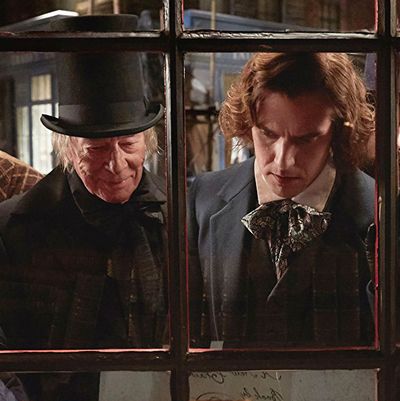
Throughout The Man Who Invented Christmas, an altogether warm, sharp, and unobjectionable family holiday film, a raven flits in and out of the frame. It is introduced as an inexplicable present to Charles Dickens (Dan Stevens) by his father, John (Jonathan Pryce), but it escapes its cage and dashes a chandelier to the ground, and CharlesÔÇÖs housekeeper declares it a sign of bad luck. It turns out to be a false omen, at least for the Dickens household; the filmÔÇÖs main obstacle, that of writing and selling A Christmas Carol, turns out fine. (Spoiler alert?) But the raven endures to the end, perched above Hatchards bookshop in London on Christmas Eve, as dozens line up in the snow to purchase the seasonÔÇÖs biggest blockbuster.
I have no idea why this raven is there, though it does evoke the raven in the savings-and-loan scene of ItÔÇÖs a Wonderful Life, Frank CapraÔÇÖs 20th-century American answer to DickensÔÇÖs 19th-century classic. The Man Who Invented Christmas, like The Christmas Carol and all stories indebted to it, continues to shore up the idea of Christmas as a secular holiday devoted to the idea of generosity, charity, and a life devoted to lightening the burdens of others. A Christmas Carol would probably get branded as communist propaganda if it were published in 2017, as CapraÔÇÖs film did in 1946. The Man Who Invented Christmas is at least savvy enough to depict its heroÔÇÖs salvation at a place of retail, the comforting ding of an old-timey till ushering us off to the credits.
IÔÇÖm probably too much of an old humbug to be the intended audience, but itÔÇÖs easy to imagine younger viewers being enchanted by Bharat NalluriÔÇÖs storybook-British, behind-the-scenes tale, which if nothing else makes the act of creating fiction look like the most exciting occupation a person could aspire to. This is no easy task, considering how many ÔÇ£author moviesÔÇØ never quite sell the spark of inspiration. As Dickens, Stevens is a restless soul with childlike intuition trapped in an adultÔÇÖs body, desperate to write a hit to make up for his Martin ChuzzlewitÔÇôera career slump. Inspiration comes to him from a series of dispiriting meetings with the various old men to whom he owes debts, and as soon as he dreams up the name ÔÇ£Scrooge,ÔÇØ the old miser appears to him quite literally, in the form of the impeccably cast Christopher Plummer.
DickensÔÇÖs ÔÇ£conversationsÔÇØ with Scrooge lead him to the rest of the story and all its various ghosts, and the question of whether or not such a miserable man could ever change. (Unfortunately for Tiny Tim, the original story apparently did not have a happy ending, much to the objection of his test audiences.) As he deals with money problems and family problems and all the various leeches knocking at his door, Dickens begins to realize that thereÔÇÖs more of him in his main character than he imagined. The ÔÇ£inventing of ChristmasÔÇØ is more of an afterthought; only when he imagines ScroogeÔÇÖs redemption can he write a hit book, forgive his parents for their past neglect, rehire the help he fired in a creative fury, and buy one of those newfangled Tannenbaums they were nuts for in Germany. One hates to think what fate would have befallen our beloved winter holiday season if Dickens hadnÔÇÖt moved all those units.

